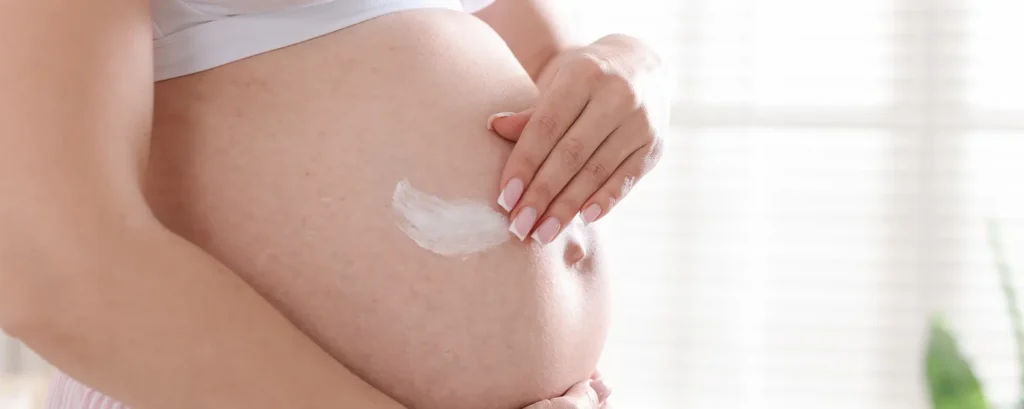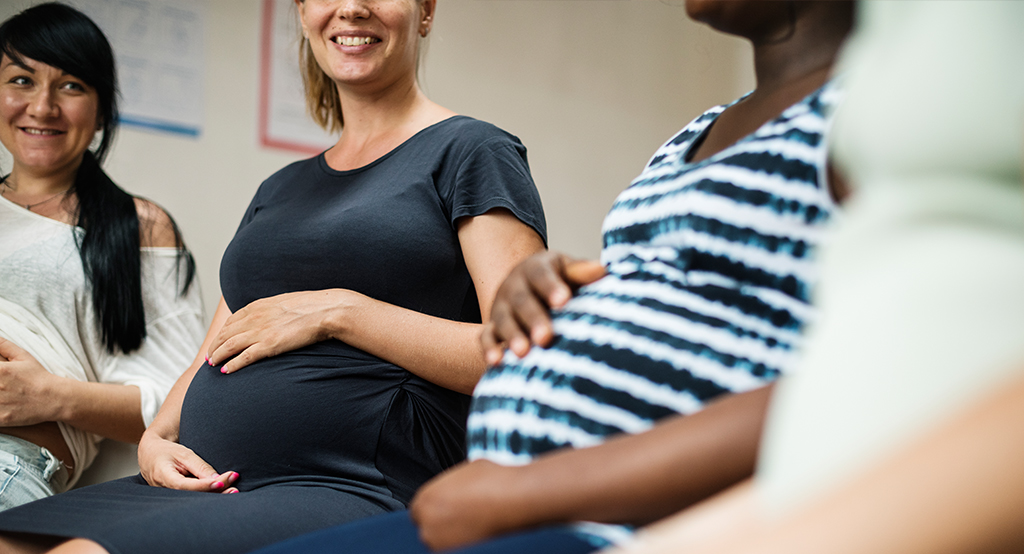Pregnancy brings excitement, anticipation and often, a few surprises when it comes to your skin.
For many women, those nine months bring a noticeable “glow.” For others, the journey involves breakouts, pigmentation, itchiness, or rashes that can feel confusing or concerning.
Most pregnancy-related skin changes are harmless and temporary, but some may signal conditions that need medical attention. Understanding what’s normal and when to call a dermatologist can help you navigate pregnancy safely and confidently.
Why Pregnancy Affects the Skin
During pregnancy, your body undergoes massive hormonal, vascular, and immune system changes to support the growing baby. These shifts affect not only your internal organs but also your skin, hair, and nails.
Key contributors include:
- Hormones: Oestrogen, progesterone, and human chorionic gonadotropin (hCG) increase dramatically, influencing oil production, pigmentation, and blood flow.
- Circulation: Blood volume rises by up to 50%, improving oxygen delivery but sometimes causing redness or spider veins.
- Immune modulation: The immune system adjusts to tolerate the foetus, occasionally triggering new rashes or sensitivities.
These physiological changes are natural but they can create a wide variety of skin responses.
The Famous “Pregnancy Glow”
Let’s start with the good news: not every pregnancy skin change is unwanted.
Many women notice brighter, plumper, more radiant skin thanks to:
- Increased blood flow giving a subtle flush.
- Hormones boosting oil and sebum production, creating a dewy look.
- Higher moisture retention in the skin barrier.
However, that same oil surge can also trigger breakouts, especially in the first trimester showing how the “glow” can be a double-edged sword.
Common and Normal Pregnancy Skin Changes

Here are the most frequent (and mostly harmless) skin changes you might notice:
1. Stretch Marks (Striae Gravidarum)
Stretch marks are perhaps the most recognisable pregnancy skin change. They appear as pink, purple, or silvery streaks across the abdomen, breasts, hips, or thighs as your skin stretches to accommodate growth.
Why They Occur:
- Rapid expansion of skin.
- Hormonal effects on collagen and elastin fibres.
What Helps:
- Regular moisturising with cocoa butter, shea butter, or hyaluronic acid.
- Gentle massage to support elasticity.
- Topical retinoids should be avoided during pregnancy but may be considered postnatally under guidance.
Stretch marks often fade in colour after birth but may remain slightly textured.
2. Linea Nigra
A dark vertical line appearing from your navel to the pubic bone, the linea nigra is completely normal.
It’s caused by increased melanin production the same pigment responsible for tanning and typically fades a few months after delivery.
3. Melasma (The “Mask of Pregnancy”)
Melasma, or chloasma, is a patchy brown or greyish pigmentation on the cheeks, forehead, or upper lip.
Why It Happens:
Oestrogen and progesterone stimulate melanocytes (pigment-producing cells), especially when exposed to sunlight.
Prevention and Management:
- Use broad-spectrum SPF 30+ daily, even indoors.
- Wear hats or visors outdoors.
- Avoid harsh peels or hydroquinone while pregnant.
- Postpartum, professional treatments like chemical peels or laser therapy can reduce lingering pigmentation.
4. Spider Veins and Redness
You may notice small, red “spider” veins on your cheeks or legs due to increased blood flow and vascular dilation.
Good news: They usually fade after birth once hormone levels and circulation stabilise.
Keeping your legs elevated and avoiding standing for long periods can help minimise appearance.
5. Acne and Breakouts
While some women experience clearer skin, others find their acne worsens during pregnancy particularly in the first and second trimesters.
Why:
Increased progesterone boosts oil (sebum) production, clogging pores and feeding acne-causing bacteria.
Safe Treatment Options:
- Gentle, non-comedogenic cleansers.
- Topical azelaic acid or glycolic acid (safe in moderation).
- Avoid retinoids, oral isotretinoin, or high-dose salicylic acid.
If acne becomes painful or severe, consult a dermatologist for pregnancy-safe prescription options.
6. Skin Darkening (Hyperpigmentation)
Beyond melasma, general skin darkening is common particularly on the nipples, armpits, inner thighs, and genital area.
This occurs in up to 90% of pregnancies and is completely harmless. It usually fades within months of giving birth.
7. Hair and Nail Changes
Increased oestrogen extends the hair growth cycle, meaning many women enjoy thicker, shinier hair during pregnancy.
However, after delivery, hormone levels drop causing temporary shedding known as postpartum telogen effluvium.
Similarly, nails may grow faster but can become more brittle or ridged. Both usually normalise within six months postpartum.
Skin Conditions That Require Extra Attention

While most pregnancy skin changes are harmless, some conditions need medical evaluation especially if accompanied by severe itching, rash, or pain.
1. Pruritic Urticarial Papules and Plaques of Pregnancy (PUPPP)
What It Is:
A common pregnancy rash that appears as red, itchy bumps or patches, often starting on the abdomen and spreading to thighs or arms.
When It Appears:
Typically in the third trimester, especially during first pregnancies or with twins.
Treatment:
- Cool compresses.
- Mild topical steroids prescribed by your dermatologist.
- Oatmeal baths and fragrance-free moisturisers.
Though uncomfortable, PUPPP is benign and resolves after delivery.
2. Pemphigoid Gestationis (PG)
A rare but more serious autoimmune blistering disorder, PG causes itchy, red plaques and blisters on the abdomen or limbs.
Why It Happens:
The immune system mistakenly attacks the skin’s basement membrane due to pregnancy-related immune changes.
When to See a Specialist:
Immediately untreated PG can cause discomfort and, rarely, complications for mother or baby.
Treatment involves oral or topical corticosteroids and close monitoring by a dermatologist and obstetrician.
3. Intrahepatic Cholestasis of Pregnancy (ICP)
Though technically a liver disorder, ICP often presents first with intense itching, especially on the hands and feet, without visible rash.
Why It Matters:
Bile acid levels rise in the bloodstream, which can affect foetal health if untreated.
Red Flags:
- Severe itch, worse at night.
- No rash.
- Dark urine or pale stools.
Action:
Contact your healthcare provider urgently. Blood tests can confirm diagnosis, and medication plus close monitoring reduce risks.
4. Atopic Eruption of Pregnancy (AEP)
This umbrella term includes eczema-like rashes triggered by hormonal and immune shifts during pregnancy.
Symptoms:
Dry, red, itchy patches on the face, neck, chest, or limbs.
Treatment:
- Emollients and gentle cleansers.
- Low-potency topical steroids if prescribed.
- Avoid irritants like scented products or wool fabrics.
Women with pre-existing eczema are more prone but can usually manage flares safely with medical guidance.
Less Common but Notable Skin Changes
Some women experience rarer but still benign issues, such as:
- Skin tags: Small growths in skin folds caused by friction and hormonal changes.
- Palmar erythema: Redness on palms due to increased blood flow.
- Vascular spiders: Small clusters of dilated blood vessels, often resolving postpartum.
Though mostly harmless, mention any sudden or widespread changes during routine antenatal visits.
Skincare Ingredients to Avoid During Pregnancy
Safety is especially important during pregnancy, as certain skincare ingredients can be absorbed into the bloodstream, cross the placenta, or interfere with the baby’s development. While many topical products are harmless, a few should be completely avoided unless approved by your healthcare provider.
Retinoids including retinol, tretinoin, and isotretinoin are at the top of the list. These vitamin A derivatives have been linked to birth defects and are strictly contraindicated during pregnancy.
High concentrations of salicylic acid should also be avoided. When used in large doses, this beta-hydroxy acid can be absorbed systemically and may cause toxicity.
Hydroquinone, a skin-lightening agent, is another ingredient to skip. It has a high absorption rate through the skin, and its safety during pregnancy has not been firmly established.
Benzoyl peroxide, commonly used for acne, should be used only under medical supervision. Although small amounts are often considered safe, there’s limited data confirming its safety at higher concentrations.
Finally, chemical sunscreens containing oxybenzone may disrupt hormones and are best replaced with mineral-based alternatives like zinc oxide or titanium dioxide.
Safe Alternatives:
- Mineral sunscreens (zinc oxide, titanium dioxide).
- Niacinamide for redness and barrier repair.
- Azelaic acid for acne and pigmentation.
- Vitamin C for gentle brightening.
Always confirm new products with your midwife or dermatologist before use.
Tips for Healthy Pregnancy Skincare
- Hydrate, inside and out.
Drink plenty of water and use a rich, fragrance-free moisturiser twice daily. - Keep sun protection non-negotiable.
Daily SPF prevents melasma and supports overall skin health. - Simplify your routine.
Gentle cleansers, moisturisers, and sunscreen are often all you need. - Avoid aggressive exfoliation.
Stick to mild physical or enzymatic exfoliants instead. - Manage itching early.
Oatmeal baths and cool compresses can soothe mild irritation. Persistent itching needs medical advice. - Support your barrier.
Look for ceramides, glycerin, and hyaluronic acid to maintain skin resilience. - Be cautious with salon treatments.
Avoid chemical peels, laser sessions, or unapproved facials until after pregnancy.
Postpartum Skin Changes
After giving birth, hormone levels drop suddenly, triggering new often temporary skin changes:
- Hair shedding: Common 2–4 months postpartum; resolves naturally.
- Melasma fading: Gradual improvement as hormones stabilise.
- Acne flare-ups: Often linked to stress and sleep deprivation.
- Dryness or dullness: Common with breastfeeding due to fluid shifts.
Continue gentle skincare and discuss any persistent issues with your dermatologist. Many treatments unsafe in pregnancy (like retinoids or stronger peels) can be reintroduced safely once breastfeeding stops.
When to See a Dermatologist
You should see a dermatologist during pregnancy or postpartum if:
- You have severe, persistent itching (especially on palms or soles).
- You develop widespread rashes, blisters, or yellowing of the skin.
- Acne or pigmentation becomes distressing or resistant to basic care.
- You experience any new skin growths or sudden changes in moles.
- Stretch marks or scarring affect your confidence and you want professional options.
A dermatologist can provide safe, evidence-based treatments tailored to your stage of pregnancy or breastfeeding, ensuring both comfort and safety.
The Psychological Side of Pregnancy Skin Changes
It’s easy to feel frustrated when your skin doesn’t “glow” the way everyone promised. But remember: these changes reflect the incredible work your body is doing.
For many women, skin issues improve after birth, while others may need a bit of professional support. Emotional wellbeing matters too never hesitate to talk about how these changes make you feel.
Your skin will find its balance again with time, care, and patience.
Frequently Asked Questions (FAQs)
1. Why is my skin darker during pregnancy?
You might notice your skin becoming darker in certain areas such as your face, neck, nipples, or inner thighs. This is due to increased melanin production triggered by pregnancy hormones like oestrogen and progesterone. The change is completely normal and temporary. Once your hormones stabilise after giving birth, the pigmentation typically fades on its own over a few months, though in some women, it can linger longer. Consistent sun protection using a broad-spectrum mineral sunscreen can help prevent the darkening from worsening.
2. Can I treat acne safely while pregnant?
Yes, but you need to be selective about what you use. Many women develop acne during pregnancy because hormonal changes increase oil production. While strong prescription products such as retinoids and isotretinoin are off-limits, you can safely use gentle cleansers, niacinamide, or azelaic acid. These ingredients help reduce breakouts without harming your baby. If your acne becomes severe or painful, your dermatologist can recommend pregnancy-safe topical or oral options that won’t put your health at risk.
3. Is it normal to feel itchy during pregnancy?
Mild itching, especially as your skin stretches over your growing bump, is common and usually harmless. However, if the itching becomes severe, particularly on your palms or soles, it may indicate a condition called intrahepatic cholestasis of pregnancy (ICP), which affects your liver function and needs medical attention. Try using fragrance-free moisturisers, oatmeal baths, or cool compresses for relief, but don’t ignore persistent or intense itching. It’s always best to check with your doctor to rule out anything more serious.
4. Will stretch marks ever go away completely?
Stretch marks often appear as red, purple, or silvery streaks on your abdomen, breasts, or thighs. While they won’t disappear entirely, they do fade significantly over time. Regular moisturising during pregnancy can make your skin more supple and may help reduce their severity. Ingredients like hyaluronic acid and shea butter are excellent for maintaining skin elasticity. After pregnancy, treatments such as laser therapy or microneedling may further improve their appearance under professional guidance.
5. Why did I develop a dark line on my belly?
That vertical line running down your stomach, known as the linea nigra, is one of the most visible skin changes during pregnancy. It’s caused by an increase in melanin, the same pigment that darkens your nipples and areolas. It’s completely harmless and typically fades within a few months after childbirth. You don’t need to apply any special creams or treatments; simply let your body’s natural healing process take its course.
6. Can I continue using my anti-ageing skincare products?
You’ll need to pause certain products while pregnant. Many anti-ageing formulations contain retinoids, chemical exfoliants, or strong acids, which are not recommended during pregnancy. Retinoids, in particular, can cause birth defects and should be completely avoided. Instead, you can switch to pregnancy-safe options such as niacinamide and vitamin C, which brighten the skin and improve tone without risk. Always read ingredient labels carefully or consult your dermatologist before continuing your usual routine.
7. Why do my veins look more visible now?
If you’ve noticed small red or blue spider-like veins on your face or legs, it’s because your body is producing more blood to support your baby. The increased pressure on your veins, combined with hormonal changes, makes them more visible. Most of these veins fade naturally after delivery. In the meantime, try to elevate your legs whenever possible, avoid standing for long periods, and wear supportive stockings if your doctor recommends them.
8. Can I get facials or salon treatments during pregnancy?
While pampering yourself can feel great, not all salon treatments are safe when you’re pregnant. Avoid any procedures that use strong chemical peels, retinoids, or lasers, as they can irritate sensitive skin or introduce unsafe ingredients. Opt instead for hydrating facials using mild, fragrance-free products. Always inform your aesthetician that you’re pregnant so they can tailor the treatment to your needs. After pregnancy, you can safely resume more intensive treatments if you wish.
9. My hair and nails are growing so fast is that normal?
Yes, it’s one of the more pleasant pregnancy side effects. The surge in oestrogen extends your hair’s growth phase, leading to thicker, shinier locks. Your nails may also grow faster, though they can become more brittle or develop ridges. After you give birth, your hormone levels drop sharply, and you might notice more hair shedding this is called postpartum telogen effluvium. It’s temporary and usually resolves within six months.
10. When should I see a dermatologist during pregnancy?
You should see a dermatologist if you notice severe itching, painful rashes, blisters, or sudden changes in your skin tone. It’s also wise to book an appointment if acne, pigmentation, or stretch marks are affecting your confidence or comfort. A dermatologist can identify whether your symptoms are normal or linked to pregnancy-specific conditions such as PUPPP or cholestasis. They’ll guide you on safe, effective treatments suitable for your stage of pregnancy and postpartum period.
Final Thought: Caring for Your Skin Safely During Pregnancy
Pregnancy transforms your skin in remarkable ways from that radiant “glow” to unexpected pigmentation, breakouts, or itching. Most of these changes are harmless and temporary, but some may need professional care to ensure both your safety and your baby’s. By understanding what’s normal and what’s not, you can feel more confident and comfortable throughout your pregnancy journey. Taking gentle care of your skin and avoiding harsh or unsafe ingredients can go a long way in keeping it healthy and balanced during this time. And remember, every pregnancy is unique, so it’s always best to seek expert advice tailored to your specific skin needs. If you’d like to book a consultation with one of our dermatologists, you can contact us at the London Dermatology Centre.
References:
1. Grigoriou, V., Zournatzi, V., Giannoulaki, E., Makrantonaki, E. and Zouboulis, C.C., 2021. Skin changes and diseases during pregnancy: A review of the literature. International Journal of Molecular Sciences, 22(21), 11970. Available at: https://www.mdpi.com/1422-0067/22/21/11970
2. Kroumpouzos, G. & Cohen, L.M., 2014. Dermatoses of pregnancy an update. StatPearls. Available at: https://www.ncbi.nlm.nih.gov/books/NBK430864/
3. Thappa, D.M. & Disigurusar, D., 2006. Physiologic skin changes in pregnancy. International Journal of Dermatology, 45(6), pp. 635-638. Available at: https://pubmed.ncbi.nlm.nih.gov/6376552/
4. Grigoriou, V. et al., 2023. The effect of pregnancy on dermatological disorders: a systematic review. Heliyon (MDPI), 9(4), eXXXX. Available at: https://www.mdpi.com/2039-7283/15/4/68
5. Geraghty, L.N. & Pomeranz, M.K., 2011. “Physiologic changes and dermatoses of pregnancy.” International Journal of Dermatology, 50(7), pp.771-82. Available at: https://pubmed.ncbi.nlm.nih.gov/21699510/
